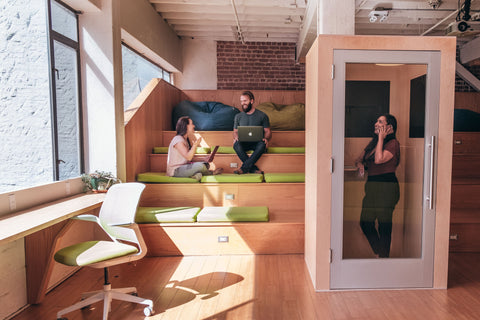Open plan offices have been popular since the 1950s, but various studies conducted over the years have revealed significant flaws in the concept. While they were initially created to cut down on business costs and promote the sharing of ideas, the open desk placement or cubicle-less environment has caused issues with productivity and wellbeing.
Open office plans save money by saving space that would otherwise be used to build physical offices, but placing employees in a large area with little to no privacy causes unwanted distractions. Add to that the potential confidentiality breaches brought on by such placement, plus the absence of quiet meeting spaces, and the end result is a decrease in productivity and increase in unhappy employees.

One way to counteract this problem is to implement the office neighborhood design. This popular idea is taking hold in a variety of settings, and even some of the largest, well-known companies are beginning to embrace it.
Now, tech giants like Uber are navigating away from the traditional open office plan in favor for one that is more conducive to work productivity and employee collaboration. According to an article titled Goodbye Open Office, Hello Office Neighborhoods, “Instead of vast floors of workers buzzing next to each other, Uber’s avant-garde plans involve organizing its new offices into ‘neighborhoods,’ creating communities of 30 to 60 employees.”
So, Exactly What Is An Office Neighborhood?
Office neighborhoods are created by grouping employees at workstations according to their specific roles at the company. Think of it as a team-based approach. If workers who collaborate on the same projects are strategically placed near one another, they will have the ability to brainstorm and share ideas easily among themselves. This approach provides a flexibility that the traditional open office plan does not, since seating is mostly random.
Each section literally functions like a neighborhood. Instead of simply owning a space, employees are given membership. Rather than just using the same desk each day, workers utilize the entire space that encompasses their neighborhood. This fosters a sense of belonging that increases both collaboration and productivity.

How Office Neighborhoods Are Created
In order to create a successful office neighborhood, employers must first understand how their staff operate. People with similar work habits will likely collaborate more productively with one another, while those with differing behaviors and tendencies may find it difficult to work closeby.
After examining the work habits of employees, supervisors can begin creating teams based on this information. This is typically accomplished by looking at all the activities a particular group will take part in during a specified time, whether it be by day, week or month. It’s all about producing the right setting to encourage concentration and support. Employees also need to be able to truly connect with one another in a positive, supportive manner.
Since a majority of work today is accomplished through collaboration, it’s essential to provide the right spaces for people to thrive. This need for space has become an especially important tool because of all the advancements in technology that require mobility and versatility.
Features of a Productive Office Neighborhood
Just as many residential neighborhoods have common areas, an effective office neighborhood will be equipped with one or more meeting spaces. These are generally small huddle rooms or booths where employees can escape for privacy when they need to focus or brainstorm.
Another feature of an office neighborhood that has become key to productivity is the presence of a project room. Single teams often gather there to collaborate for the duration of a particular assignment.
One great benefit of such a space is that team members can leave their work out on display, and it will remain uninterrupted because no one else will be using the room until that project is complete. This enables the team to own that space while the project is in progress, giving its members a home base.

Another distinct advantage of creating office neighborhoods is the ability group members to customize their own mix of open floor space and individual rooms.
For instance, one might use the floor space as a hive for activity, while reserving the huddle rooms for a private, relaxing workspace. Another might prefer the floor to remain quiet and to use the rooms for collaboration and activity. It’s all based on the needs of each neighborhood’s members and how they work together.
How Office Neighborhoods Save Space
Office neighborhoods are becoming space-savers by enabling companies to use their real estate more wisely. While the initial idea of open office plans called for as many desks or cubicles as possible to accompany a given space, office neighborhoods are encouraging company owners to be more creative. Though the amount of space they have at their disposal hasn’t changed, how it’s used can really make a difference in terms of productivity and employee satisfaction.
Before settling on a particular office neighborhood configuration, it’s best to have important conversations ahead of time so compromises and negotiations can be made to prevent problems from occurring in the future. For example, it would be a good idea for the employees who will occupy a given office neighborhood to discuss habits such as listening to music while at work, or other distracting behaviors.
Knowing how each person works best helps neighborhood members eliminate distraction and create a more effective workspace.
Thinking about how work will happen in an office neighborhood environment ahead of time will necessitate productive conversations. When members are encouraged to contribute equally to the situation, they feel an integral part of what is going on around them. This, in turn, generates positive energy, which translates into a higher level of creativity.
From time to time it's important to re-evaluate each neighborhood to determine what is working and what isn’t. This will require teams and their managers to regularly return to the established protocols for these specific areas. This will serve to inform new employees of the rules and give them an opportunity to provide valuable feedback if change is needed.
Office neighborhoods can also promote employee well-being. When people feel like an appreciated member of a team or neighborhood, they will be more inclined to readily share ideas and information. Instead of deciding not to speak up in meetings for fear their ideas won’t be considered important or assuming no one will agree with their way of thinking, they will feel like their contributions matter because of the team mentality that office neighborhoods instill.

These spaces designated for similar activity stimulate a sense of togetherness that the traditional open office plan doesn’t. It’s all about finding better, more efficient ways to work, and the office neighborhood accomplishes just that.
Setting Up the Office Neighborhood
Phone pods are a great solution for customizing the workplace to fit a wide variety of needs. These modular units, manufactured and sold by Zenbooth, create endless opportunities for setting up office neighborhoods. These small rooms create quiet spaces for individuals to work in peace or for groups of two to meet and brainstorm in private.
The phone booth is the answer to creating a collaborative environment that will increase productivity because it gives employees that needed space to complete individual projects free of distraction. They are easy to assemble and can be moved with no hassle.
Zenbooths are available in different sizes, woods, and finishes to meet a wide range of preferences, decors, and needs. Choose the comfort booth to accommodate individuals or the executive booth for meetings of two people.
All work booths are acoustically insulated, so occupants can’t hear distracting noise from the outside, and people on the open office floor won’t be privy to private conversations taking place inside the room. A double-paned glass door is also included for added noise reduction.
The modular units are spacious and bright, thanks to the inclusion of a full skylight ceiling. This produces a well-lit space that fosters productivity.
Electrical and USB charging outlets are available to accommodate laptops and mobile devices, thereby adding to the capability of booth occupants. A quiet ventilation system controls the climate and is even designed to become inactive when the booths are not in use. All of Zenbooth’s products are eco-friendly, made of only locally sourced, recycled materials.

Office phone booths add versatility to the office neighborhood setting by providing a wealth of features commonly found in individual offices. They are, however, practical because of their smaller size and portability. They save organizations money because they provide a dynamic, imaginative alternative to the open office environment.
Learn more by visiting our contact page and getting in touch with one of our product experts.